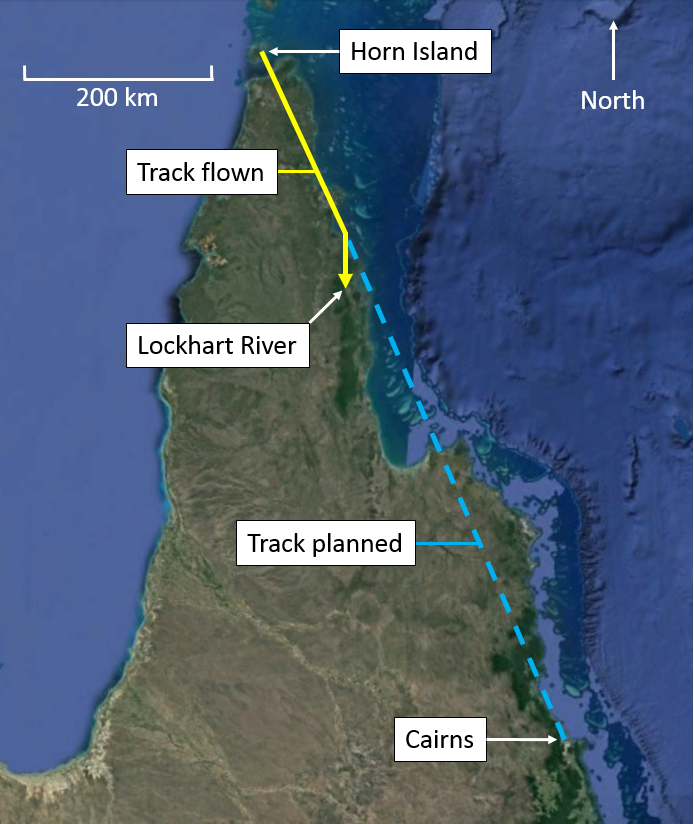What happened
At 1446 Eastern Standard Time (EST) on 12 July 2016, a Westwing Aviation Cessna 208 aircraft, registered VH-NTQ (NTQ), departed Horn Island Airport, Queensland (Qld), for a scheduled passenger flight to Cairns, Qld, with a pilot and seven passengers on board.
As the aircraft climbed towards the planned cruising altitude of 9,000 ft, the pilot began to feel light-headed, dizzy and short of breath. The pilot levelled the aircraft at 9,000 ft and engaged the autopilot. They then attempted to identify a reason for the symptoms, selected air conditioning off, opened a fresh air vent and ate a snack. No reason for the symptoms could be identified. As the flight continued, the symptoms intensified, the pilot felt tingling in their hands and fingers, and large head movements caused severe nausea.
About 20 NM north of Lockhart River, the aircraft approached a significant over-water segment. The pilot assessed that the symptoms would not pass and elected to divert to Lockhart River (Figure 1).
The aircraft landed at Lockhart River without further incident, the pilot and passengers were not injured, and the aircraft was not damaged.
Figure 1: Overview of planned flight

Source: Google Earth, modified by ATSB
Pilot comments
The pilot of NTQ provided the following comments:
- They were well rested and fit to fly prior to commencing the day’s duties.
- Prior to departing Horn Island, they were well nourished and hydrated.
- While conditions were not perfect, they elected to conduct a visual approach as large head movements exacerbated their symptoms.
- They had no pre-existing conditions which may have contributed to the incident.
- After landing, the symptoms quickly subsided and have not recurred.
Operator comments
The operator of NTQ provided the following comments:
- An engineering inspection of NTQ identified no defects. The aircraft has returned to service with no abnormalities reported.
- The operator interviewed the passengers the following day. No passenger reported experiencing symptoms similar to the pilot.
- After landing, an inspection of passenger baggage and aircraft cargo identified no dangerous goods.
Medical examinations
The pilot underwent medical examinations after landing in Lockhart River and the following day in Cairns. No contributing irregularities were identified.
ATSB comment
While the pilot did not return to Horn Island at the onset of the symptoms, the pilot’s decision to divert to an en route airport as the symptoms intensified rather than continuing to the intended destination demonstrates appropriate cautiousness in the face of uncertainty about their own ability to continue the flight.
Safety message
The ATSB safety education publication Pilot incapacitation occurrences 2010–2014 (AR-2015-096) documents recent pilot incapacitation occurrences in high-capacity air transport, low-capacity air transport, and general aviation to help educate industry about the causes and risks associated with inflight pilot incapacitation.
The ATSB report Pilot incapacitation: Analysis of medical conditions affecting pilots involved in accidents and incidents examined medical conditions and incapacitation events between 1 January 1975 and 31 March 2006. This report concluded that the majority of pilot incapacitation events do not involve a chronic or pre-existing medical condition. They are largely unforeseeable events, often involving acute illnesses or injury. Many are not in themselves life-threatening, but are capable of impairing a pilot’s performance to the extent that safe operation of the aircraft may be adversely affected.
Aviation Short Investigations Bulletin - Issue 53
Purpose of safety investigationsThe objective of a safety investigation is to enhance transport safety. This is done through:
It is not a function of the ATSB to apportion blame or provide a means for determining liability. At the same time, an investigation report must include factual material of sufficient weight to support the analysis and findings. At all times the ATSB endeavours to balance the use of material that could imply adverse comment with the need to properly explain what happened, and why, in a fair and unbiased manner. The ATSB does not investigate for the purpose of taking administrative, regulatory or criminal action. TerminologyAn explanation of terminology used in ATSB investigation reports is available here. This includes terms such as occurrence, contributing factor, other factor that increased risk, and safety issue. Publishing informationReleased in accordance with section 25 of the Transport Safety Investigation Act 2003 Published by: Australian Transport Safety Bureau © Commonwealth of Australia 2016
Ownership of intellectual property rights in this publication Unless otherwise noted, copyright (and any other intellectual property rights, if any) in this report publication is owned by the Commonwealth of Australia. Creative Commons licence With the exception of the Coat of Arms, ATSB logo, and photos and graphics in which a third party holds copyright, this publication is licensed under a Creative Commons Attribution 3.0 Australia licence. Creative Commons Attribution 3.0 Australia Licence is a standard form licence agreement that allows you to copy, distribute, transmit and adapt this publication provided that you attribute the work. The ATSB’s preference is that you attribute this publication (and any material sourced from it) using the following wording: Source: Australian Transport Safety Bureau Copyright in material obtained from other agencies, private individuals or organisations, belongs to those agencies, individuals or organisations. Where you wish to use their material, you will need to contact them directly. |


